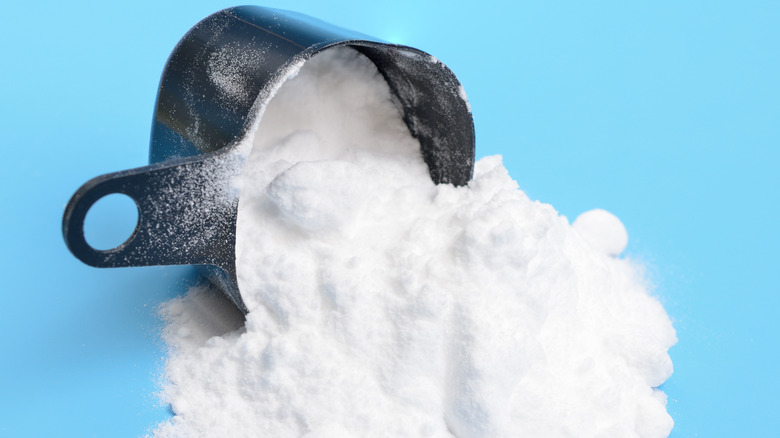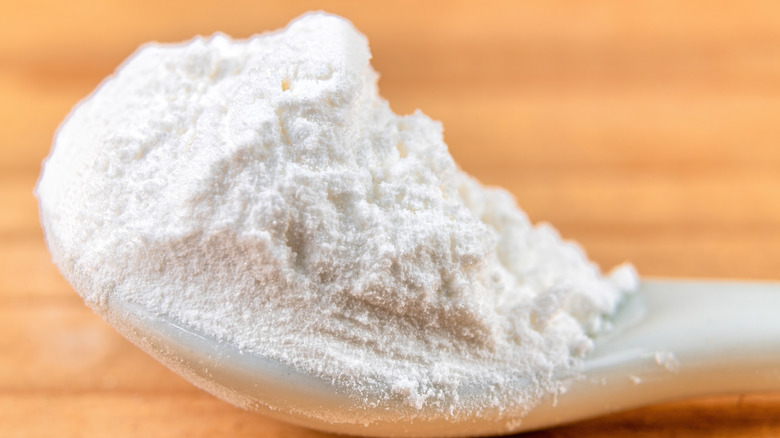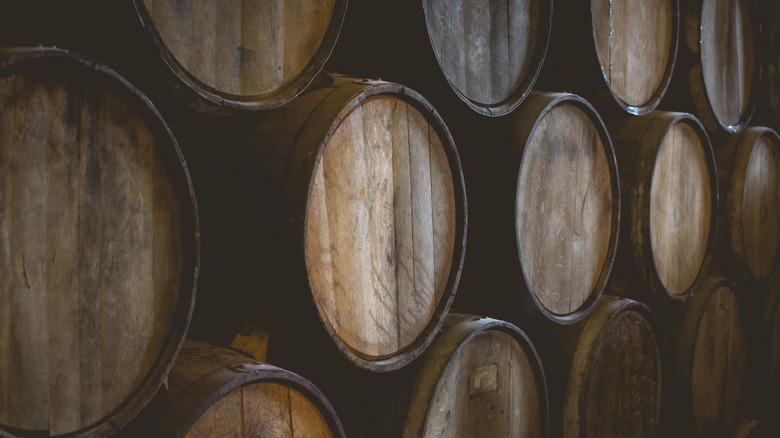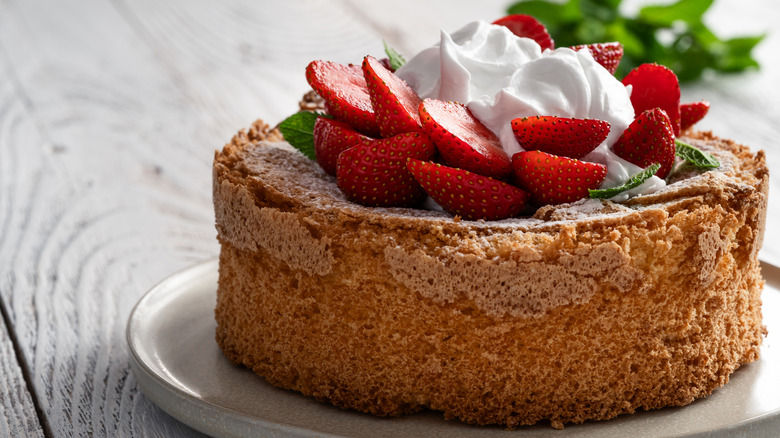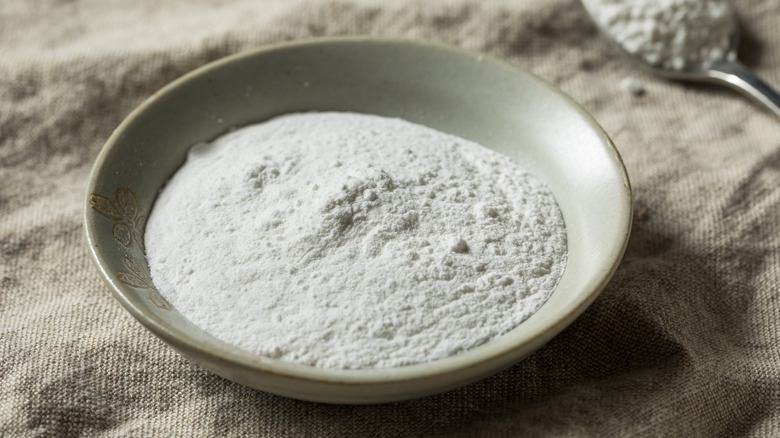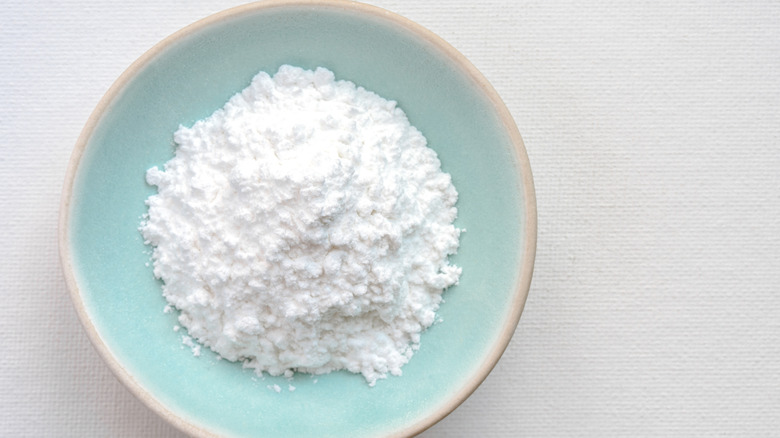What Exactly Is Cream Of Tartar?
We may receive a commission on purchases made from links.
Cream of tartar is one of those culinary ingredients that feels like a riddle wrapped in an enigma — it doesn't come in the form of a cream, it was not invented by the Tartars, and it's not related to Scottish tartan, either. Luckily, we're here to break down what exactly cream of tartar is and why you can't go another day without having it in your pantry.
It's no secret that cooking is a science. After all, it's impossible to achieve the perfect cake without leavening agents, to make gravy without emulsification, or even to cook bacon without caramelization. All of these processes, methods, and ingredients usually come down to simple chemical compounds and their anything-but-simple interactions. But it's not every day that we encounter an ingredient that, though pretty straightforward, is so misnamed and so misunderstood that most of us would rather just pass it by than try to figure it out. World, meet cream of tartar.
As a baker, cook, and food writer over At the Immigrant's Table with over 12 years of professional experience, I've learned when cream of tartar is absolutely indispensable and when you can make do with other ingredients or a different technique. So read on to learn all there is to know about cream of tartar and its uses in the kitchen.
What is cream of tartar?
Before we can delve deeper into how to use it, let's break down once and for all what cream of tartar actually is.
Cream of tartar is the popular name of potassium bitartrate, or potassium hydrogen tartrate, also known as KC₄H₅O₆. This chemical compound actually comes, believe it or not, from the winemaking industry, where it forms naturally along the inner walls of wine barrels during fermentation. Despite its name, cream of tartar contains neither dairy nor gluten, making it naturally vegan and suitable for gluten-free baked goods.
At its core, cream of tartar is an acid, similar to vinegar or citrus — except it does so much more than just add sour notes to your dishes. But don't confuse cream of tartar with tartar sauce, another tangy and delicious ingredient whose uses go far beyond being an accompaniment for fish. In fact, cream of tartar is part of what gives wine its tang — but you'll have to read on to understand that.
How is cream of tartar made?
Cream of tartar is not a chemically created cooking aid, but a naturally occurring substance. As grape juice ages in barrels, undergoing fermentation, some of the tartaric acid in grapes mixes with other naturally floating materials like tannins and dead yeast and turns into little crystal-like sediments known in the chemistry world as "tartrates". They take on the hue of the grape skin with which they mix (purple from red grapes, yellow from white), and can even be seen stuck to a cork or in the bottom of a wine bottle.
After the wine is removed from the barrel, the substance is scraped off, purified, ground, and packaged as a white powder. Historically, it had a different name at each step of this process — argol or argal while naturally occurring in a barrel, and beeswing after being harvested. The process of turning this sediment into purified white crystals and calling it tartar, or tartare, goes back to at least the 14th century.
A breakthrough in using cream of tartar came in the 1840s, when it was discovered that mixing it with baking soda — a known agent used to give chemical rise to baked goods — could greatly augment bakers' consistency. Cream of tartar was imported from France and Italy (two winemaking giants), and helped improve and regularize the effects of baking soda, which up to that point weren't always predictable. Thus, cream of tartar became a must for every baker — but only until 1856, when a Harvard chemist replaced cream of tartar with calcium acid phosphate in modern baking powder.
What does cream of tartar taste like?
While cream of tartar is far from poisonous, it's fair to say you wouldn't want to eat it raw. It has an acidic flavor that is both tangy and sour, though milder than lemon or vinegar. It doesn't taste metallic like baking powder and won't leave you with a bitter aftertaste. Think of biting into a lemon, but without any of its bright, fruity notes. Because it's ground into a powder, cream of tartar tastes chalky and can leave your mouth feeling dry if consumed straight.
When used in baking, cream of tartar is usually not noticeable by taste. This is part of its charm — it is fast acting and efficient without overshadowing any of the star players of a recipe, like a good supporting actor or a beautiful bass or drum sequence. When paired with sugar, it can even be said to balance the sugar out, toning down the sweetness.
How to cook with cream of tartar
Because cream of tartar is an acid, it can be used to add acidity to recipes without adding liquid — like adding citric acid to hummus. But its main use is as a stabilizer in baked goods. Cream of tartar can be added to give volume when whipping egg whites, helping them maintain their peak shape for longer. This is especially useful when making souffles without mistakes, or meringue for key lime pie or pavlovas. Cream of tartar is also the one ingredient that is crucial for making an angel food cake so high, light, and airy, everyone will wonder if you used magic when baking it (well, the one ingredient besides egg whites). Because it's an acid, cream of tartar discourages browning, helping your cake stay pristinely white.
The real magic of cream of tartar lies in its use as a leavening agent. When cream of tartar, an acid, is combined with baking soda, a base, it causes a reaction that creates carbon dioxide bubbles and gives baked goods height. It acts immediately upon addition and has no metallic aftertaste, making it an ideal for delicate baked goods like snickerdoodles. Cream of tartar was also key in old-fashioned candy-making recipes, as it prevents sugar crystallization in syrups and candies like lollipops. Add a pinch of cream of tartar to your freshly cooked caramel, and you'll help it stay smooth and silky for a while.
Surprisingly, you can also use cream of tartar to help your fruits and veggies last longer. Soak produce in a solution of 1 cup of water and 1/4 teaspoon of cream of tartar to prevent them from oxidizing and turning brown.
Where to buy cream of tartar
The good news is that you're unlikely to have to head to specialty stores to look for this vintage ingredient. Cream of tartar is readily available in most grocery stores year-round. You will typically find it in the spice aisle or the baking section. Head to most major retailers like Kroger, Safeway, Publix, Aldi, and Albertsons for your cream of tartar fix. Typical brands include McCormick, Club House, Watkins, and store brands like Great Value by Walmart.
Because its uses today are somewhat limited and it's not as popular or widely utilized as baking powder or baking soda, cream of tartar is typically packaged in small quantities in containers ranging from 1.5 to 3.5 ounces. When buying cream of tartar, look for a white powder without any clumps or discoloration, as those can point to moisture being locked in the container. Though brands may claim otherwise, there's really very little difference in quality between different types of cream of tartar, so feel free to choose whichever is cheapest — and spoiler alert, they will all be fairly affordable.
Purchase cream of tartar on Amazon.
Nutritional information about cream of tartar
On its own, cream of tartar holds little nutritional value beyond its chemical capabilities, though it does have a great deal of potassium. Cream of tartar contains 8 calories, 2 grams of carbohydrates, and 11% of the daily recommended intake of potassium in just one teaspoon.
Cream of tartar is also an excellent cleaning agent that can be used in place of baking soda to polish silver and appliances or to remove rust and even stains. Alas, none of those have health benefits beyond the contribution of a clean home to your mental health.
Curiously, cream of tartar was historically used as a medicinal remedy for all manner of ailments, from gout to rabies. A 2003 study has shown that a daily dose of 5 grams of cream of tartar can possibly help relieve constipation. It is also touted as a natural aid for quitting smoking, relieving migraines, treating acne, and even lowering blood pressure and aiding weight loss. However, there is little to no modern scientific proof to support any of these claims.
How to store cream of tartar
Cream of tartar can have a long shelf life when stored properly. In fact, it is virtually indestructible, which is why so many of us have small amounts of cream of tartar hanging out in the back of our spice drawer for months or even years without much notice.
There are, however, a few rules to keeping cream of tartar fresh over time. Once you bring it home, store cream of tartar in a well-sealed container, as it can absorb moisture and develop lumps if exposed to humid environments. It is best kept sealed in a cool, dry place without access to direct sunlight or excessive changes in temperature. As mentioned, your spice drawer would make a perfect spot, as would your baking pantry or a dedicated storage shelf with other stable ingredients. But like all oils and spices, it's best to keep cream of tartar away from the direct heat of the oven, stovetop, or any appliance that generates significant heat.
Replacements for cream of tartar
Despite the fact it lasts forever — and it's relatively inexpensive — we do realize that cream of tartar may not be a pantry staple for everyone. If you are dealing with a recipe that calls for cream of tartar, there are some easy cream of tartar alternatives you can turn to, depending on the use. And most of these are probably in your kitchen already!
For its stabilizing or leavening qualities, and for its bright flavor, lemon juice can sub for cream of tartar in angel food cake. For stabilizing egg white-laden creations like meringue, use two to four times as much white vinegar as you would cream of tartar. For giving rise to baked goods in recipes that call for baking soda alongside cream of tartar, baking powder is a natural replacement — but keep in mind that baking powder will replace both the cream of tartar and baking soda. Buttermilk is another acid that can work in baked goods calling for cream of tartar, but you will need to reduce the other liquids in the recipe to compensate. Similarly, yogurt diluted with water will also serve as a replacement if you're looking to give your baking moisture and tang.
